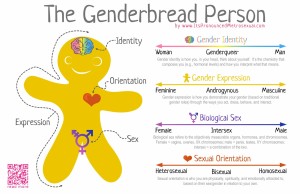
A quick, simple guide for those unfamiliar with the many components that may contribute to a person’s gender identity.
What does ‘transgender’ mean?
‘Transgender’ is an umbrella term often used to refer to people whose gender identity differs from their assigned sex at birth. However, people whose gender identity differs from their assigned sex at birth may not self-identify as transgender; some may identify as transsexual, trans, genderqueer, a person of transgender experience, etc. Transgender people may or may not use a different name or pronoun than the one they were assigned at birth, and they may or may not pursue hormone therapy or surgery. When in doubt, always defer to the way a person self-identifies.
How is sexual orientation different from gender identity?
Sexual orientation describes an individual’s enduring physical, romantic, emotional, and/or spiritual attraction to another person (for example: straight, gay, lesbian, bisexual). Gender identity is someone’s personal sense of their own gender (for example: male, female). Like people who are not transgender, transgender people may identify their sexual orientation as straight, lesbian, gay, or bisexual.
The Legal Status of Transgender People
Transgender people almost always deal with discrimination – much of which is perfectly legal. Many legal and administrative policies that regulate gender make it difficult for transgender people to go about their daily lives. Various forms of legal identification have different, and often stringent, rules about changing gender that leave many transgender people with little or no option for correct or consistent documentation, leading to problems in the long run. In addition, most states and countries offer no legal protections in housing, employment, health care, and other areas where individuals experience discrimination based on their gender identity or expression. Offensive stereotypes about transgender people only make matters worse.
Statistics
- According to a study from the Anti-Violence Project (AVP), 40% of anti-LGBT murder victims in 2011 were transgender women. Transgender women made up only 10% of anti-LGBT violence survivors.
- In the same study, AVP found that transgender people of color were 28% more likely to experience physical violence compared to the rest of the sample of LGBT and HIV-affected people.
- In a report from the National Transgender Discrimination Survey (NTDS) conducted by the National Gay & Lesbian Task Force and the National Center for Trangender Equality, transgender people faced double the rate of unemployment of the general population.
- The same NTDS report found that while discrimination was pervasive throughout the transgender sample, transgender people of color, and especially African American transgender people, were consistently fare worse than white respondents.
- 63% of transgender people in the NTDS report sample had experienced a serious act of discrimination that majorly affected their abilibty to sustain themselves, such as loss of a job due to bias, physical and sexual assault due to bias, homelessness because of gender identity/expression, or bias-motivated denial of medical service.
The Leeway Foundation is a wonderful resource for Trans & Women artists in the Philadelphia Area. I was honored to receive an Arts & Change Grant for In Visible Skin and I cannot speak highly enough of this organization. They do amazing, supportive work.
Philadelphia is home to The Mazzoni Center, a LGBT health care center that specializes in Trans Health.
Mazzoni also sponsors The Philadelphia Trans-Health Conference, an annual conference that focusing on the Trans community and it’s allies. The Trans-Health conference is open and free to the public.
The Attic Youth Center is a wonderful, wonderful Philly organization that provides support for LGBTQ youth.
“Invisibility is indivisible from visibility; for the transgender this is not simply a philosophical conundrum — it can be the difference between life and death.”